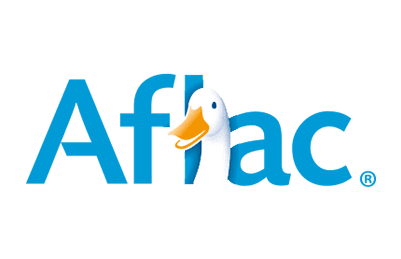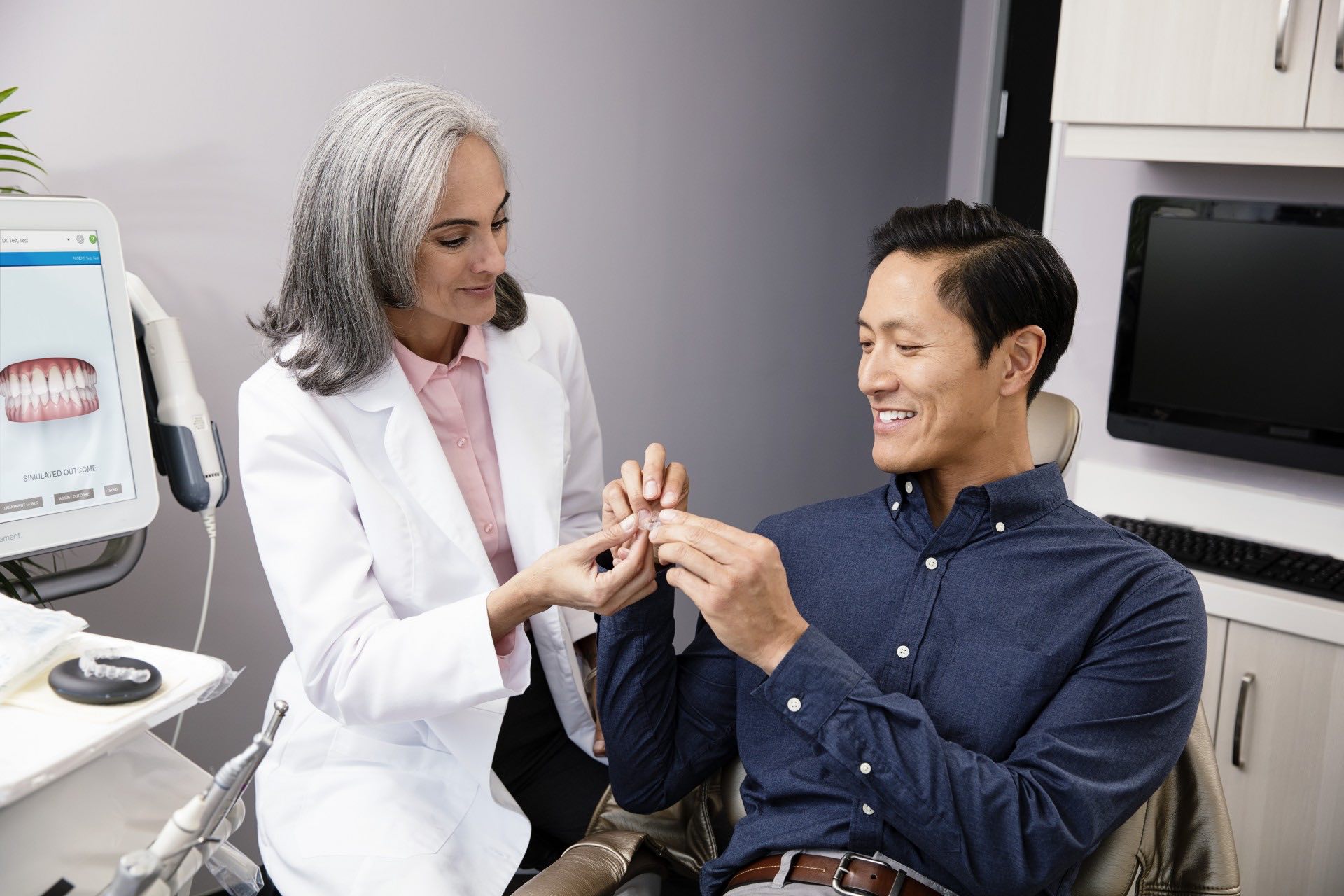
Invisalign™
Invisalign™ is a series of durable clear aligners interchanged every three weeks that gradually move specified teeth into ideal occlusion or bite.
Plan Your Visit Now
Begin the Change
“A smile is a curve that sets everything straight.”

Invisalign®
- Invisalign®
- Malocclusion
- Cosmetic
- The process
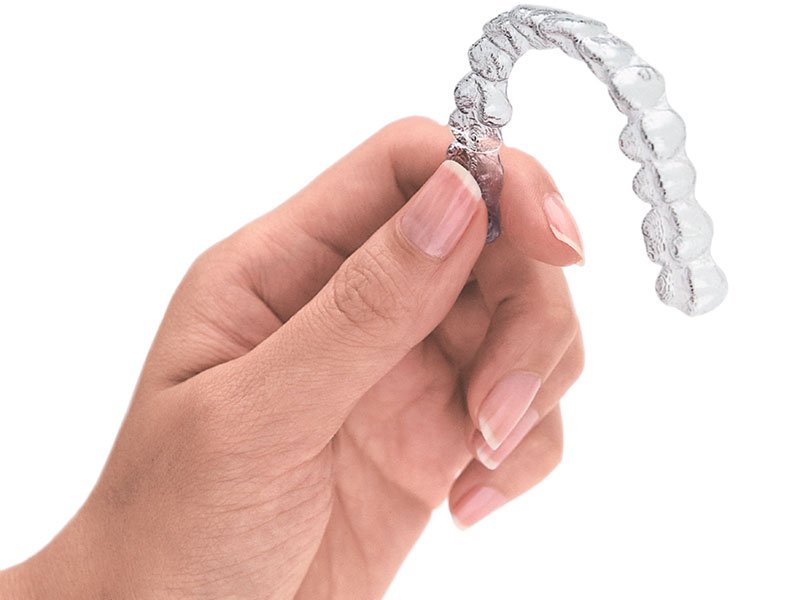
What is Invisalign®?
Invisalign® is a series of durable clear aligners interchanged every three weeks that gradually move specified teeth into ideal occlusion or bite. The treatment is used to re-align teeth for proper fit, function, and cosmetic re-alignment.
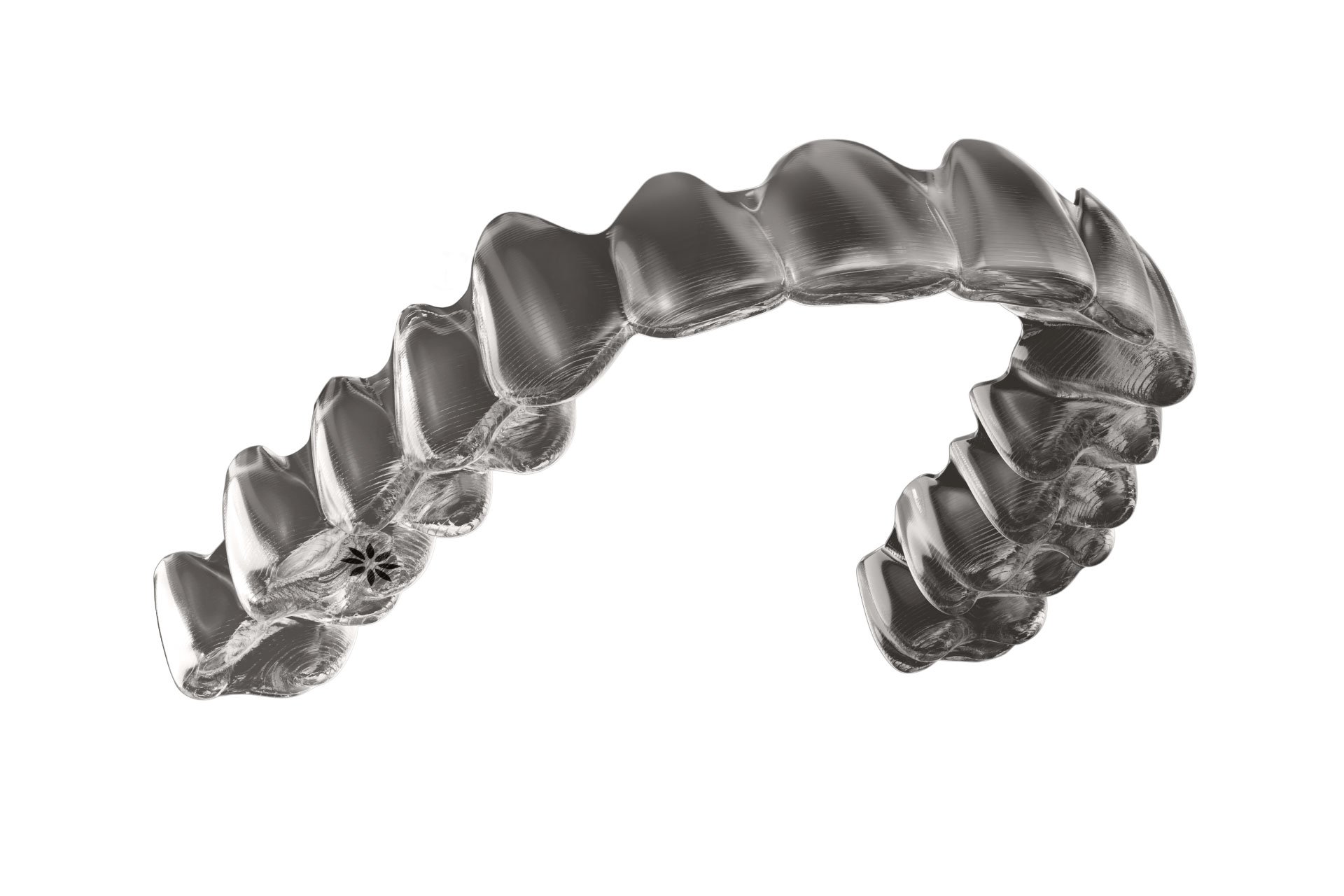

If you would like to take an Invisalign® smile assessment
Malocclusion (off bite)
Malocclusion symptoms:
- Abnormal alignment of teeth
- Abnormal appearance of the face
- Difficulty or discomfort when biting or chewing
- Speech difficulties (rare) including lisp
- Mouth breathing (breathing through the mouth without closing the lips)
- Jaw, neck and back pain
- TMJ disorder
- Headaches
- Recurring chipped, cracked or broken teeth
- Excessive plaque and tarter build up (around crooked teeth)
You may be surprised to know that the benefits of having properly aligned teeth extend far beyond a confident smile. According to the American Dental Association, straightening your teeth can significantly affect your overall dental health.
A stable and properly aligned bite is very important to your oral health. Most people are not well informed about it, and truthfully, providers are just now coming around as well. In your mouth, teeth are embedded in your upper and lower jaw bone by a root. The jaw acts as the axis of a car, and your teeth act as the tires. If one tire out of four is out of alignment, then the entire car axis is off, and that can cause serious problems.
Your upper and lower jaws come together in a harmonious relationship that allows you to chew, speak, and swallow. Some people are born with or develop malocclusion over time. Developmental problems are usually addressed as a pre-teen but sometimes there is a reoccurrence of misalignment if final retainers are not worn constantly or other changes have taken place.
Missing teeth, worn down teeth, and faulty dental restorations, will affect your overall bite. Ideally, your bite should always be taken into consideration when planning major dental work. A bite problem that wasn’t there before could appear if dental work isn’t fitted or adjusted properly. Tooth sensitivity and pain can sometimes be resolved with a simple bite adjustment.
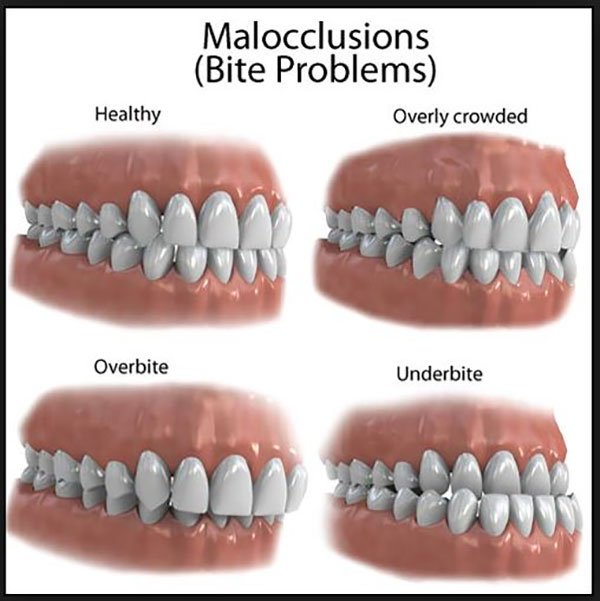
Cosmetics
 Invisalign® (Invisalign® Culver City) not only helps correct misaligned teeth and an ‘off bite’ but also to straighten them to a more symmetrical and appealing appearance. Cosmetic dentists often incorporate invisalign® as phase one of a comprehensive smile makeover. Shifting and re-aligning teeth to an ideal position before placing multiple crowns is one of the best ways to achieve optimal results. Also, your case can be designed to re-align your back teeth but separate your front teeth, making it possible to for very minimal cutting of teeth for veneers or crowns.
Invisalign® (Invisalign® Culver City) not only helps correct misaligned teeth and an ‘off bite’ but also to straighten them to a more symmetrical and appealing appearance. Cosmetic dentists often incorporate invisalign® as phase one of a comprehensive smile makeover. Shifting and re-aligning teeth to an ideal position before placing multiple crowns is one of the best ways to achieve optimal results. Also, your case can be designed to re-align your back teeth but separate your front teeth, making it possible to for very minimal cutting of teeth for veneers or crowns.
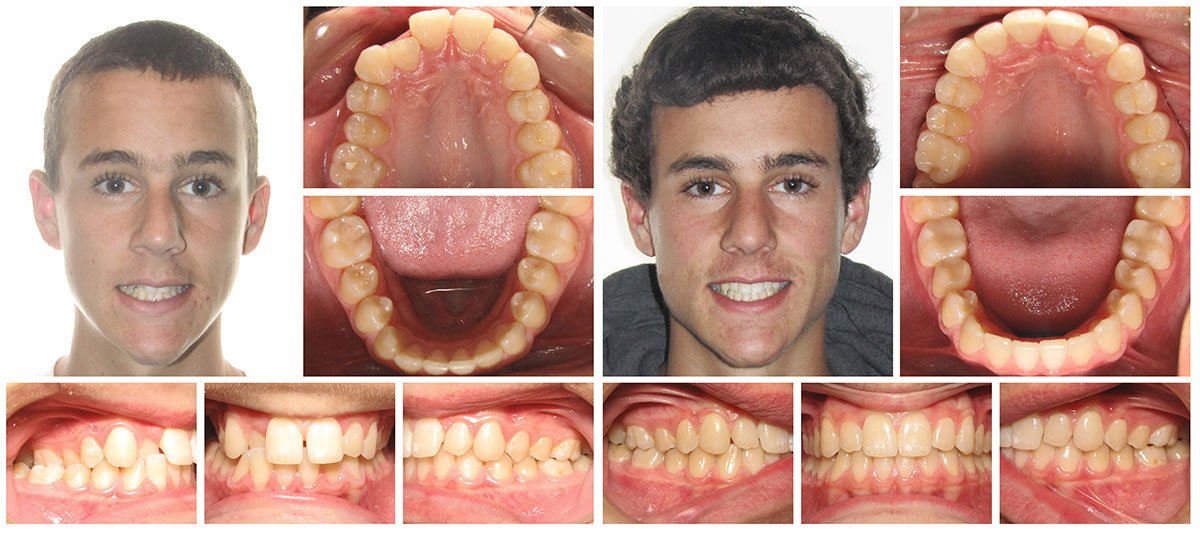
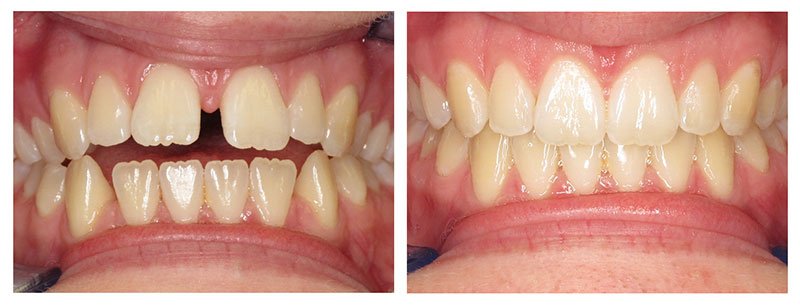
The process
Phase one: Records

Align Technologies, the lab that fabricates your Invisalign™ trays, requires various records to fully assess if optimal results can be achieved with Invisalign™. The records are used for the development of your treatment plan and fabrication of aligners. Most offices charge a non-refundable fee for Invisalign® records, which is applied to the cost of the overall treatment. In most cases, Dr. Talaie can usually access right away whether or not you are a good candidate for Invisalign® treatment. The only question might be whether or not you qualify for Invisalign® Express (10 sets of aligners or less) case or Full case (10 sets or more of aligners).
Records include:
Full mouth set of recent x-rays, intraoral photos, series of facial photos, upper and lower impressions, bite registration
Align Technologies receive records in just under a week, and a digital case work-up begins. Models of your upper and lower jaws are scanned to create a 3D simulation of your mouth and current bite. Clinical data and notes provided by Dr. Talaie get incorporated into creating the ideal position of teeth for the final case presentation.
Phase two: Clin Check
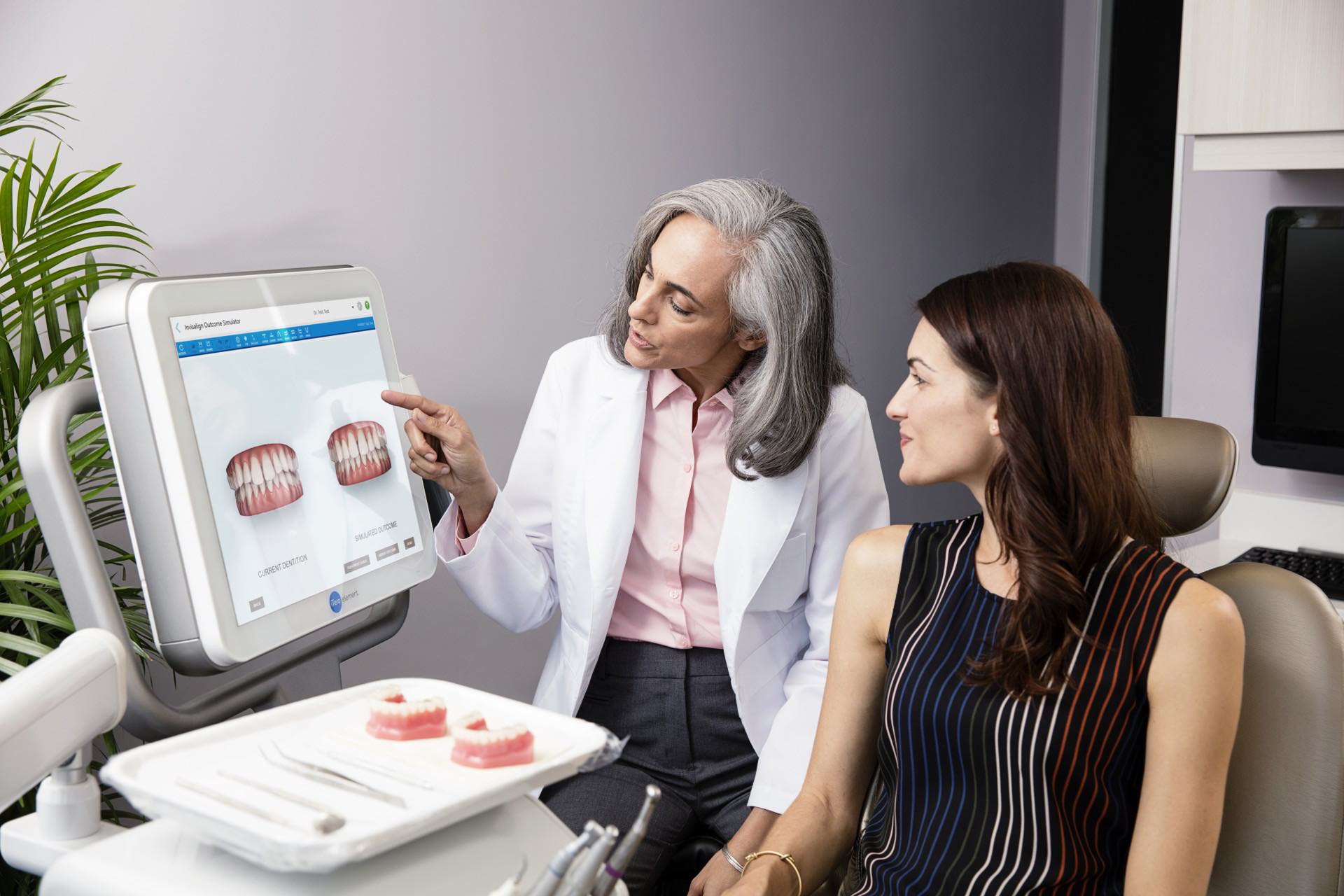 Once your Invisalign® (Invisalign® Culver City) case is ready for final approval and manufacturing, a ‘clin check’ notice is e-mailed to the doctor for review. The ‘clin check’ is like a time-lapse digital movie showing the progression of treatment. Views of the lower, upper arch are available as well as front and side views. In time-lapse, you can see all sides of your mouth moving into an ideal position. At this point, additional instructions or other specific clinical accommodations can be included in the final treatment plan. Once the Doctor and patient are satisfied with the simulated results and treatment plan, the case is approved aligners are manufactured. They take 2-4 weeks to be made and delivered.
Once your Invisalign® (Invisalign® Culver City) case is ready for final approval and manufacturing, a ‘clin check’ notice is e-mailed to the doctor for review. The ‘clin check’ is like a time-lapse digital movie showing the progression of treatment. Views of the lower, upper arch are available as well as front and side views. In time-lapse, you can see all sides of your mouth moving into an ideal position. At this point, additional instructions or other specific clinical accommodations can be included in the final treatment plan. Once the Doctor and patient are satisfied with the simulated results and treatment plan, the case is approved aligners are manufactured. They take 2-4 weeks to be made and delivered.
Phase three: First set of aligners
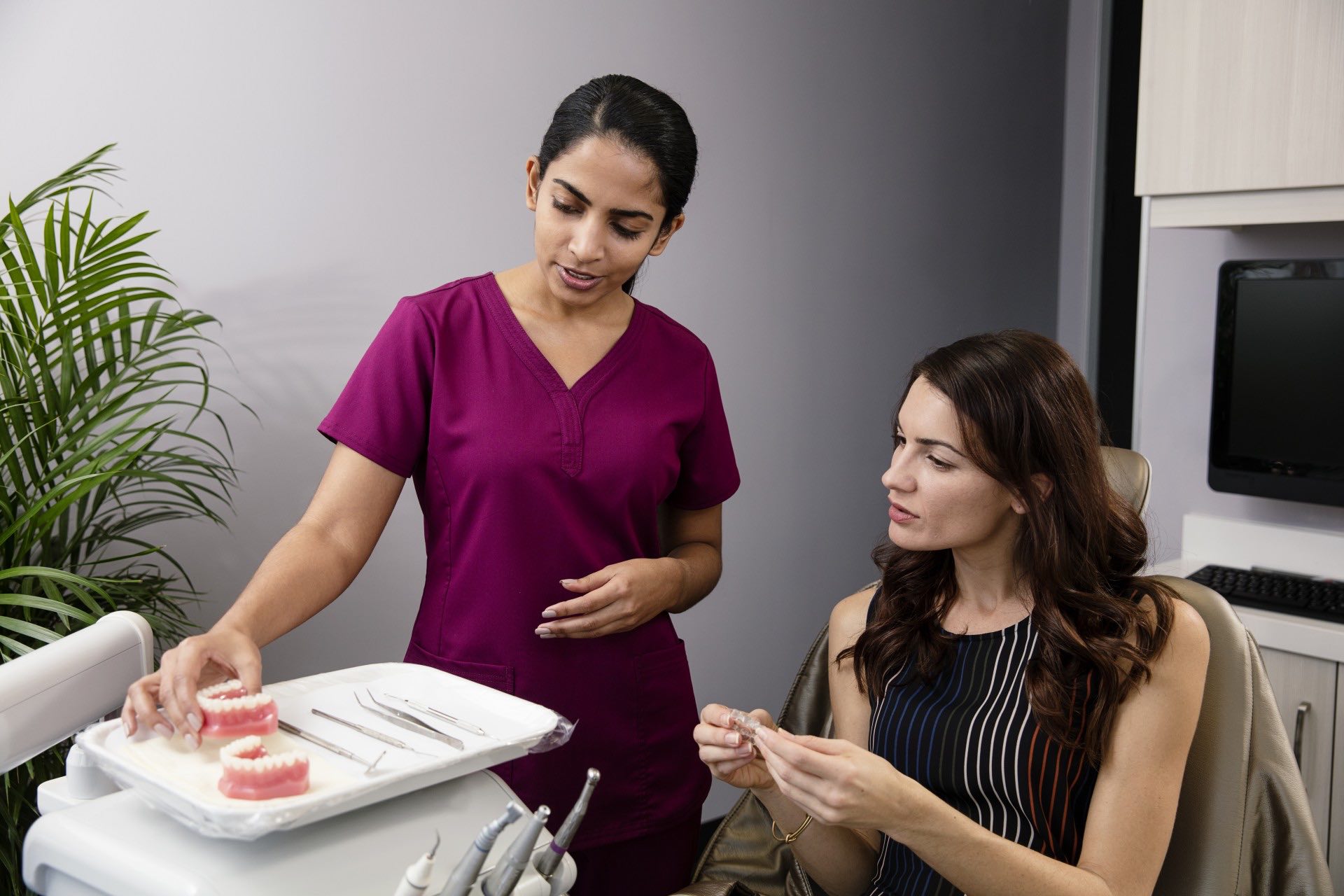 The first visit is usually the longest as the doctor prepares the teeth for the aligners to do their intended function. Buttons, made of tooth-colored filling material, are placed on specified teeth for proper movement. Think of them as an anchor to keep certain teeth stable or drag others into the ideal position. Sometimes only a few buttons are placed, and others are added later into treatment-or, not at all. They are removable and will not affect your natural tooth in any way. IPR, (interproximal reduction), is also done at this time. Some teeth may need a little room to move into an ideal position. Millimeters of a specified tooth are reduced in key treatment areas that are blocked from proper movement. IPR is not always indicated and the patient can request to limit this procedure
The first visit is usually the longest as the doctor prepares the teeth for the aligners to do their intended function. Buttons, made of tooth-colored filling material, are placed on specified teeth for proper movement. Think of them as an anchor to keep certain teeth stable or drag others into the ideal position. Sometimes only a few buttons are placed, and others are added later into treatment-or, not at all. They are removable and will not affect your natural tooth in any way. IPR, (interproximal reduction), is also done at this time. Some teeth may need a little room to move into an ideal position. Millimeters of a specified tooth are reduced in key treatment areas that are blocked from proper movement. IPR is not always indicated and the patient can request to limit this procedure
At this time the patient receives their first three sets of aligners to be worn for three weeks each. The patient is then encouraged to make an appointment for nine weeks out, to check progress and provide new sets of aligners.
Phase four: Treatment
During this phase, the patient returns only to pick up new aligners and monitor the progress of treatment. There may be new buttons to place or IPR to be done before starting a new set of aligners. Most of the time, a quick ‘in and out’ visit is all there is. If the patient is noncompliant and inconsistent with wearing the aligners as specified, a mid-course correction and delay of treatment may happen. Lost or missing aligners can always be re-ordered quickly.


Phase five: Final retainer
Once the patient is finished wearing their last set of aligners, they are ready for a final impression for final retainers. The dentist will remove the buttons on the teeth at this stage, and an impression and bite registration will be taken.
The final delivery of the retainer will be about two weeks. You must wear final retainers as much as the regular aligners – but only for a period of time. Eventually, you will wean yourself off and only wear them at night. They are more durable than the regular Invisalign® aligners but must be worn 24/7 for 6-12 months after treatment. Your first set is included with your case. Extra sets can be made for an additional price.
What Are Clear Aligners?
Clear aligners are essentially a form of dental braces used to correct the occlusion or bite of your teeth. They are usually a clear and transparent plastic that adjusts your teeth much as braces do. The need for clear aligners depends significantly on the person receiving them and the severity of the patient’s initial dental alignment.
How Do Clear Aligners Work?
Clear aligners, like Invisalign®, do not only correct off-bite or misaligned teeth, but they also straighten your teeth for a more aesthetic dental appearance. In addition, clear aligners put a small amount of pressure on your teeth, enabling incremental movements to your teeth’s alignment.
Your custom set of clear aligners will come with attachments. These attachments are points of pressure that grip onto specific teeth to help them shift to an appropriate position.
You will be given several sets of Invisalign® trays that you will switch out every 2-3 weeks. Each set is customized to fit your teeth, and the pressure is adjusted so your teeth will continue to move gradually with each set.
Symptoms of an Off-Bite
Your off-bite, also known as malocclusion, may not even be noticeable enough to think you need Invisalign treatment. Some symptoms include:
- Discomfort or difficulty while chewing
- Speech difficulties
- TMJ disorder
- Excessive breathing through the mouth
- Jaw, neck, and back pain
- Headaches
While these symptoms may not be visibly noticeable, they could be underlying issues with your bite that you are not aware of. Straightening your teeth with Invisalign offers many benefits to your overall dental health.
More obvious symptoms include:
- Misaligned teeth
- Abnormal facial appearance
- Recurring broken, cracked, or chipped teeth is a sign of an abnormal bite.
When your teeth are not aligned properly, it can cause issues for the rest of your dental and oral health.
Benefits of Invisalign® / Clear Aligners
The following are four benefits from Invisalign® / clear aligners:
1. They are removable.
Unlike braces, where you have to watch what you eat and how you eat, clear aligners are removed every time you eat, brush, floss, etc. The aligner should be worn at least 22 hours of the day but can be taken out for short periods for work and other social occasions.
They are transparent.
Aligners are plastic-like trays that are barely visible. They are thin and transparent and placed over the teeth for a less noticeable way to achieve alignment. Clear aligners are great for people who rely on a professional look that braces cannot give them. If you need a less noticeable way to straighten your smile, Invisalign is a great option.
They are much more comfortable.
Unlike braces, Invisalign usually is much more comfortable. The initial switch to an updated set of aligners can be uncomfortable because they are trying to realign your teeth. However, you do not want to remove them often; otherwise, they won’t work, so the initial discomfort will eventually pass.
Braces are usually bulky in the mouth and can get caught on your lips or cheeks, while aligners sit over the tooth and are barely noticeable.
It is important to remember that while Invisalign is a good option for many people, more complex and severe cases of misalignment may only require the help of braces for maximum effect. Invisalign is suitable for those with lives requiring a professional image and more simple tooth alignment.
Invisalign vs Braces
One of the most well-known orthodontic treatment options is braces, but in recent years, clear aligners like Invisalign have become the forefront of the orthodontic conversation. More and more people understand that they have more options than just braces to help straighten their teeth to a better position.
However, despite this treatment option, the question remains: Do I need braces or Invisalign?
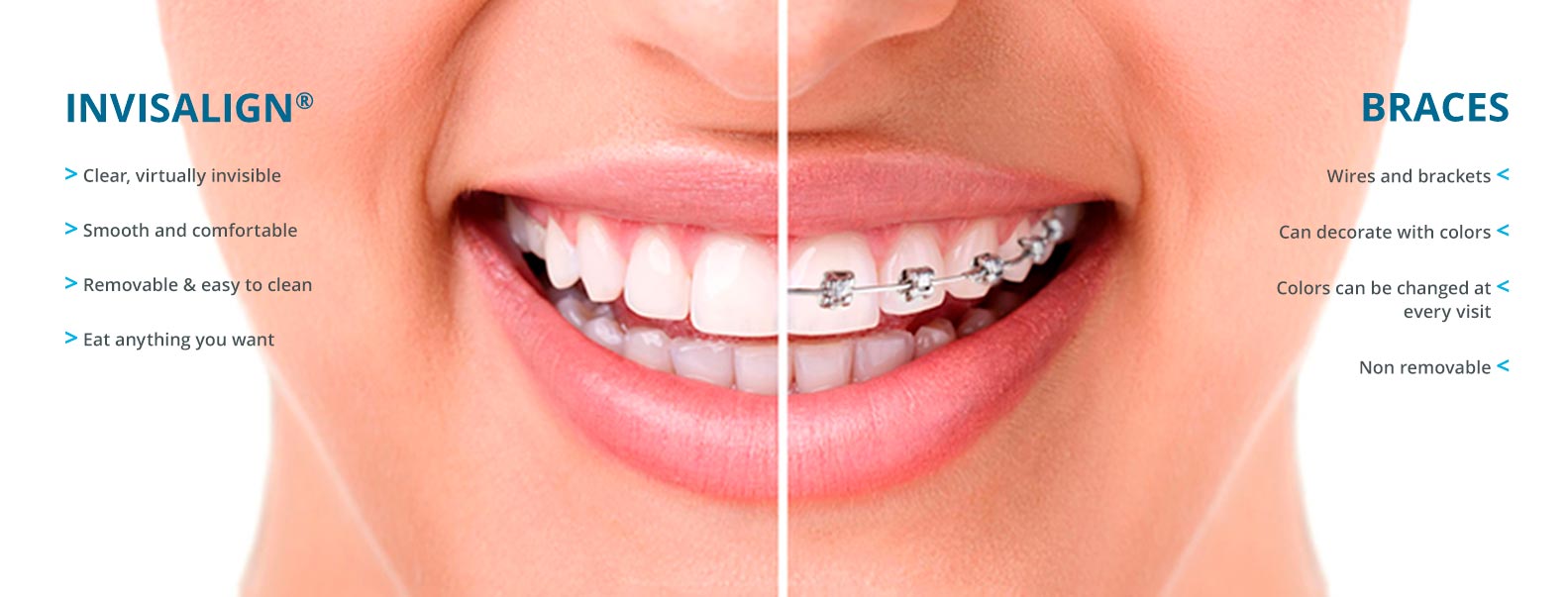
WHAT ARE BRACES?
With braces, teeth are moved to the correct position using metal wires and brackets applied to the outside of the teeth. As a well-known technology from the 1800s, we know it works. Often, a band connects the top and bottom brackets to add a tighter fit to the braces. An orthodontist regularly tightens the metal brackets to ensure the movement continues until the teeth are in the correct position.
WHAT IS INVISALIGN?
An Invisalign aligner is a clear plastic device worn over the teeth to facilitate tooth movement. As each set of aligners is made using 3D technology, they tighten over the teeth to ensure they are always moving. Undeniably, this unique technology has been around long enough to know that it works and can provide an incredible alternative. It is often the most preferred method to facilitate tooth movement.
INVISALIGN OR BRACES?
When it comes to orthodontic dental treatment, your dentist and orthodontist will know what is best for you. To make a sound decision, you should listen to what they have to say.
To assist you in making an informed decision, we have compiled a list of pros and cons between braces and Invisalign.
WHAT MAKES INVISALIGN BETTER THAN BRACES?
It is important to remember that while Invisalign is a good option for many people, more complex and severe cases of misalignment may only require the help of braces for maximum effect. Invisalign is suitable for those with lives requiring a professional image and more simple tooth alignment.
1. Aesthetically, Invisalign is better.
1. Aesthetically, Invisalign is better.
Unlike braces, Invisalign are multiple trays of clear aligners that fit directly over the teeth and cannot be easily detected. This is great for adults who do not want braces in their professional or personal life and want something more discrete. The most common braces are the metal brackets and wires that fit on your teeth. Even though the color can be changed to whatever you want, including clear, the brackets will still be noticeable.
2. Maintenance and convenience, Invisalign is better.
2. Maintenance and convenience, Invisalign is better.
Unlike braces, Invisalign does not have to be removed by your dentist. However, removing them when brushing your teeth and eating is necessary. It is crucial that they are worn for at least 22 hours per day. It’s best not to take them off too often. As a result, you can eat whatever you want, whenever you want, without worrying about dental care routines.
Since braces cannot be removed, you must avoid eating anything hard or sticky while wearing them. It would also require you to do a more thorough at-home cleaning.
3. Comfort, Invisalign is better.
3. Comfort, Invisalign is better.
It is almost impossible to feel Invisalign working, even though it is moving your teeth slowly. As you switch to a new pair of aligners, you may experience some discomfort initially due to the tighter fit, but it subsides rather quickly.
It is common for braces to cause pain, especially after they are taken in and tightened by your dentist or orthodontist. The braces may also get caught on the gums, which will cause pain.
WHAT CAN’T INVISALIGN FIX?
As we have already seen, Invisalign offers aesthetics, comfort, and ease of use. However, despite all these options, Invisalign may not be your best option. So what would prevent Invisalign from being the best option for you?
During your first orthodontic appointment, your orthodontist will assess your case to determine the best treatment plan. Although Invisalign or any clear aligner will correct your bite and align your teeth, they may not be the right choice for you in severe cases.
Braces may be the best choice if you have a severe alignment or bit issue. In cases where jaw, tooth, and facial movement is required to restore a smile and align a bite, braces are the strongest and most effective option because they use metal brackets, wires, and bands to pull the teeth together.
See if Invisalign or braces will work for you by speaking with your dentist and orthodontist.
Invisalign Culver City
Did you know there are over 50 searches each month from people searching “Invisalign Culver City” that generate 56 clicks to a website like Century Smile Dental?
That’s a lot of searches and clicks for people like you wanting a more beautiful smile! Maybe you didn’t search for “Invisalign Culver City” to find us, maybe you searched “Culver City Invisalign” which gets 30 searches a month, or you searched another term. Regardless, we are happy you are here. We are easy to get to if you are located in Culver City, Culver – West, Century City, Inglewood, Palms, Baldwin Hills, Cheviot Hills, or Playa Vita. Call us to schedule an appointment at 310-836-6161 or Book Online below.
PRELIMINARY STEPS FOR INVISALIGN
Before getting your Invisalign trays, an appointment with your dentist is necessary to ensure the proper bite and fit are created.
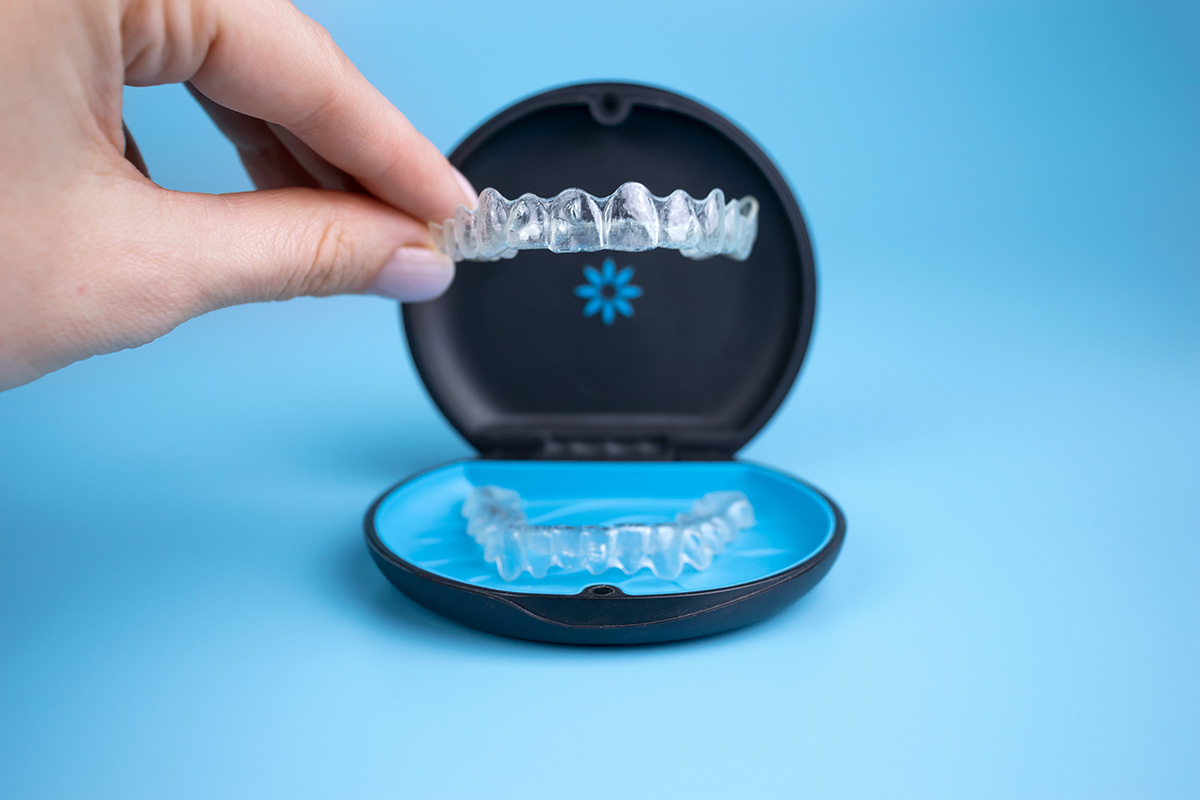
First, an impression is taken either digitally using an intraoral scanner or traditionally using impression material. If a traditional impression is taken, then that impression will later be scanned into a 3D image to create the Invisalign. This impression will create an entire scan of your teeth, bite, and help to map out a perfect treatment plan.
Once this scan is complete, the data is sent off to create the Invisalign trays.
Once the trays are brought into the office, the dentist will set an appointment for you to assess the fit. This step is vital in making sure the Invisalign trays will properly move the teeth week to week.
It is normal to feel tightness and discomfort in the area within the first few hours of wearing the trays. This is because those first few hours are crucial in aiding tooth movement. While Invisalign does not cause pain and discomfort in the same way braces do, their focus is to move the teeth, so some tightness is essential to feel.
During this initial appointment, your dentist can answer all questions regarding the Invisalign and provide the proper care steps and what to expect moving forward.
I’m Wearing Invisalign; Now What?

The standard treatment time for Invisalign is around 6 months; however, the severity of the case will determine if more or less time will be needed. Regardless, you will start witnessing a change in your bite and smile within the first couple of weeks.
Once you go home with your new Invisalign treatment option, you must ensure they work correctly.
Invisalign is a great orthodontic tooth movement option for those who live a professional life and do not want their day-to-day life interrupted.
Invisalign must be removed when brushing your teeth and eating, allowing you to continue eating whatever foods you want and find zero change in your dental routine.
Invisalign is completely transparent, making it difficult to see. This helps with aesthetics and allows you not to feel self-conscious when talking, laughing, or smiling with friends, family members, or coworkers.
However, it is vital to understand that you must wear your Invisalign for at least 22 hours of the day. That means that eating and brushing your teeth must be done in a timely manner to avoid having the device off for too long. Invisalign works beautifully, but it won’t work well if you are not using the device properly.
How Long Does Invisalign Take?
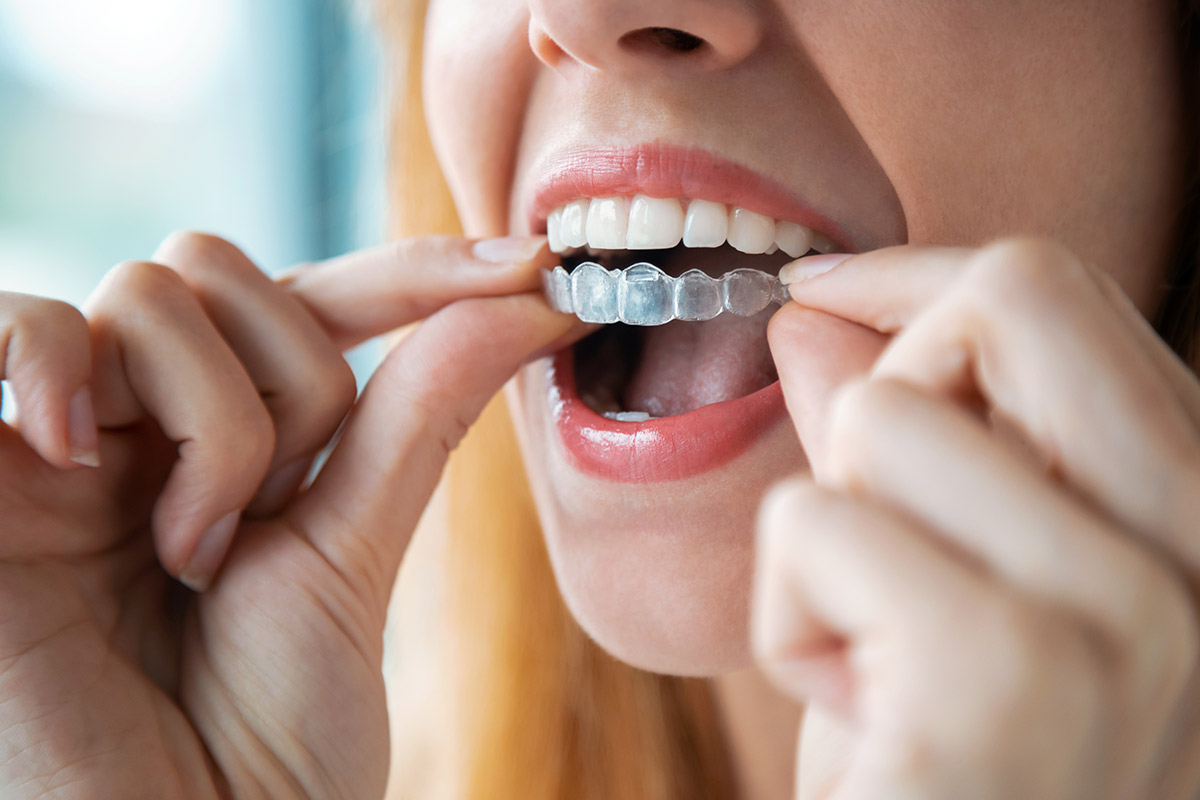
Your dentist will help you set up regular dental appointments every few weeks to check the progress of your Invisalign and switch you out with a new set of trays.
Invisalign uses pressure on the teeth to help move teeth by making the device tight, so it’s crucial to replace the trays regularly. Generally, your Invisalign needs to be replaced every 1-2 weeks to aid in tooth movement, but your dentist can provide a more accurate timeline.
Upon completion of your aligners, your dentist will schedule an appointment to check your progress and switch your aligners. As a result, your teeth will gradually straighten until the results are achieved.
Depending on the results, your dentist will make adjustments if necessary. However, allowing teeth to move at a reasonable pace is vital, as fast adjustments can weaken and break the teeth.
It usually takes about six months to a year for Invisalign to perfectly realign your teeth, giving you a straighter, more beautiful smile and an increased sense of self-confidence.
Insurance
Our office will verify benefits for orthodontic treatment. The amount the insurance will pay for treatment minus the total cost of treatment is patient’s out of pocket. All estimated out of pocket costs and financial arrangements must be paid in full prior to receiving final sets of aligners (not to be confused with final retainers). Additional fees for final retainers, or lost aligners, may be applicable. Everyone’s situation is different, and we will work with you on ways to help cover the cost of treatment.
Financing
We are now offering financing through:






Give Us A Call At 310.836.6161 Or Request An Appointment Online



